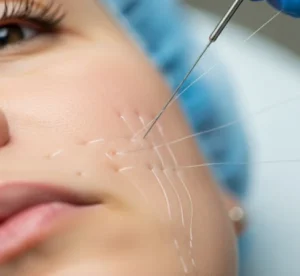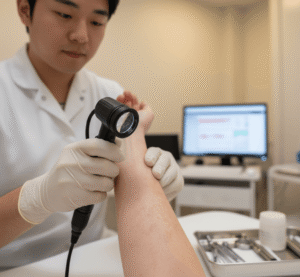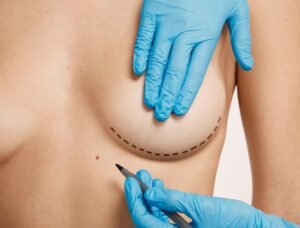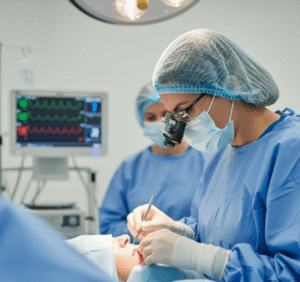Overview
An epigastric hernia occurs when fat or tissue pushes through a weak spot in the abdominal wall between the breastbone and the belly button. While often small, these hernias can cause pain, discomfort, or complications if left untreated.
Epigastric hernia repair is a surgical procedure that closes the defect in the abdominal wall, restoring normal anatomy and preventing future complications.
In South Korea, this surgery is performed in advanced general surgery and minimally invasive centers, using modern laparoscopic or open surgical techniques. Korean hospitals are known for their precision, safety, and rapid recovery protocols, making them an excellent choice for adults requiring hernia repair.
What is Epigastric Hernia Repair?
Epigastric hernia repair involves returning the herniated tissue or fat to its proper place and reinforcing the abdominal wall to prevent recurrence.
The procedure is recommended for adults experiencing:
- Pain or discomfort in the upper abdomen
- Visible bulging or swelling along the midline of the abdomen
- Complications such as obstruction or strangulation of herniated tissue
- Elective correction for cosmetic or preventive reasons
Repair can be performed using:
- Open surgery → traditional incision and direct repair
- Laparoscopic surgery → minimally invasive approach with small incisions, less pain, and faster recovery
What are the benefits?
Epigastric hernia repair offers several advantages:
- Eliminates bulge and discomfort → restores normal abdominal contour
- ➤ Prevents complications such as strangulation or obstruction
- ➤ Minimally invasive options → laparoscopic surgery reduces pain and hospital stay
- ➤ Durable repair → use of mesh reduces recurrence risk
- ➤ Quick recovery → most patients resume normal activities within 1–2 weeks
- ➤ High success rates in Korea with expert surgeons and modern techniques
Procedure Details
1) How should I prepare for Epigastric Hernia Repair?
Proper preparation is crucial for safe surgery:
- Medical evaluation → blood tests, imaging, and review of medical history
- Medication adjustment → anticoagulants or blood-thinning drugs may require temporary discontinuation
- Fasting → typically no food or drink 6–8 hours before surgery
- Smoking cessation → improves healing and reduces complications
- Informed consent → discuss surgical options, risks, and expected outcomes
2) What happens during the procedure Epigastric Hernia Repair?
The procedure typically takes 1–2 hours depending on complexity:
- Anesthesia → general anesthesia is commonly used
- Incision → open surgery involves a midline incision; laparoscopic repair uses several small incisions
- Hernia reduction → herniated tissue or fat is returned to the abdominal cavity
- Wall reinforcement → defect is closed with sutures or mesh to prevent recurrence
- Closure → incision is sutured, and sterile dressing is applied
In Korea, surgeons often prefer laparoscopic repair for adults because it offers less pain, faster recovery, and smaller scars, while open repair is reserved for large or complicated hernias.
3) What happens after an Epigastric Hernia Repair?
- Immediate recovery → patients are monitored in recovery for vital signs and complications
- Pain management → analgesics or mild opioids are prescribed
- Activity restriction → avoid heavy lifting or strenuous exercise for 4–6 weeks
- Follow-up → wound check and suture removal if needed, usually within 1–2 weeks
- Long-term outlook → patients can resume normal activities gradually, with minimal recurrence risk
Risks / Benefits
Potential Risks:
- Temporary pain, swelling, or bruising
- Infection at the surgical site (rare)
- Recurrence of hernia → more common without mesh repair
- Rare complications → bleeding, organ injury, or anesthesia-related issues
Key Benefits:
- Eliminates pain and bulge caused by hernia
- ➤ Prevents life-threatening complications such as strangulation
- ➤ Minimally invasive techniques → faster recovery and smaller scars
- ➤ Durable results with mesh reinforcement
- ➤ High success and safety rates in Korea
Recovery and Outlook
- Short-term recovery → mild discomfort and limited activity for the first week
- Functional improvement → pain and bulge are relieved, allowing gradual return to work and daily tasks
- Long-term outlook → most patients enjoy lasting relief and minimal recurrence
- In Korea, patients benefit from modern surgical techniques, expert follow-up, and rapid recovery protocols
When To Call the Doctor
Contact your healthcare provider if you experience:
- Severe abdominal pain or sudden swelling
- ➤ Signs of infection such as redness, warmth, or discharge
- ➤ Fever or unusual fatigue
- ➤ Persistent nausea or vomiting
- ➤ Bulge recurrence or sudden changes at the surgical site
Early evaluation ensures safe recovery and prevention of complications.
Best Korea Option / Process
South Korea offers world-class hernia repair services:
- Expert general and laparoscopic surgeons → highly skilled in adult hernia repair
- Modern laparoscopic equipment → precise, minimally invasive repair with faster recovery
- Comprehensive care packages → preoperative assessment, surgery, and postoperative follow-up
- Outpatient or short hospital stay → minimal disruption to daily life
- International patient services → multilingual support, appointment scheduling, and personalized care
Patients choosing Korea for epigastric hernia repair can expect safe, effective, and durable outcomes, making it a top destination for adult hernia surgery in Asia.













